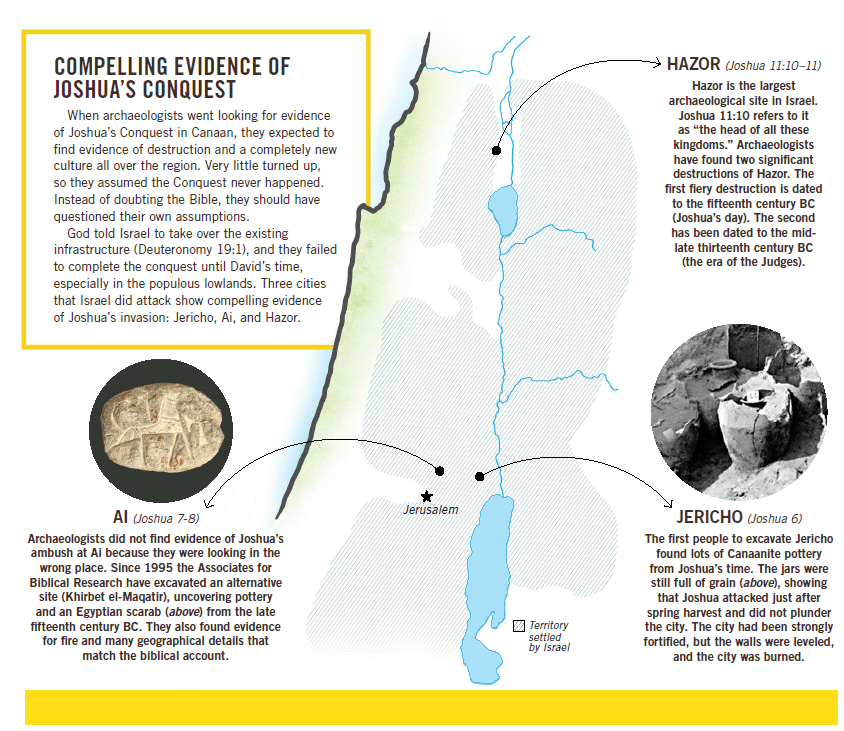Archaeology’s Lost Conquest
When Palestine was first opened to archaeologists, they were excited to seek evidence of Israel’s Conquest. When the findings didn’t match their expectations, they decided to throw out the Bible rather than question their assumptions.
Archaeological research in the Holy Land began in earnest in the 1800s, driven by a keen interest in the history of Bible lands. Joshua’s Conquest of Canaan soon became an important focus. Unfortunately, two developments eventually led most scholars to deny that the Conquest ever happened.
At first the digs were promising. One of the first cities excavated in Israel was Jericho, the first stop in Joshua’s campaign of conquest in the Promised Land. A group of German scholars did the first excavations at Jericho in the early 1900s. In the 1930s, British archaeologist John Garstang started new excavations at Jericho, finding local Canaanite pottery from Joshua’s time and evidence for massive destruction by a fierce fire, including ash deposits up to 3 feet (1 m) thick. The evidence was consistent with an Israelite attack on the city around 1400 BC, the biblical date for the Conquest.1
Then in the 1950s, Garstang’s colleague Kathleen Kenyon continued excavations at Jericho, but she reached a much different conclusion: Jericho was not destroyed at the time of Joshua but 150 years earlier, around 1550 BC. Indeed, she claimed the Canaanite city was unoccupied when the Israelites supposedly entered the land. Hence, there was no city for the Israelites to conquer.
Kenyon’s conclusions quickly became scholarly dogma.
Kenyon’s conclusions quickly became scholarly dogma. Those conclusions are still held tenaciously by most archaeologists and Old Testament scholars, despite the work of a later archaeologist, Bryant G. Wood, who demonstrated Kenyon’s dating errors and lack of in-depth analysis of the pottery.2
What led to this rejection of the Bible’s timeline? Before Kenyon’s pronouncements, archaeologists had difficulty finding archaeological evidence of a large population influx and widespread destruction throughout Canaan around 1400 BC. They had expected to find lots of evidence that Israel had overthrown the old Canaanite cities and culture and established their own, unique material culture throughout the land.
Since evidence for such an influx seemed to be missing, they developed a new idea: the arrival of the Israelite people must have coincided with military clashes in Canaan during the thirteenth century BC. (This was the violent era of the Judges, though secular archeologists don’t recognize this connection.) The promoter of this idea was William F. Albright.3
In due course, archaeologists were unable to find enough archaeological evidence to finger the Israelites as thirteenth century invaders, either. As a result, a majority of archaeologists and Old Testament scholars jettisoned any notion of a historical Conquest at all and began formulating esoteric and unbiblical theories for the origin of Israel.4
So, what are serious-minded Christians to do about this “problem”?
Biblical Chronology
First, we must carefully turn our attention to the text of Scripture to properly ascertain when the Conquest took place. Predictably, present-day liberal scholars largely ignore the chronological data in the Bible that clearly indicates the time of the Conquest. Further confusing the issue, a number of prominent evangelical scholars have accepted the thirteenth-century-BC date for the Conquest, trying to correlate the archaeological evidence with that timeframe.5
The primary biblical reference, 1 Kings 6:1, leaves no room for doubt. “In the 480th year after the people of Israel came out of the land of Egypt, in the fourth year of Solomon’s reign over Israel, . . . he began to build the house of the Lord.” The date Solomon began building the Temple is well established as 967 BC.6 Simple addition places the Exodus at 1446 BC,7 and the Conquest at 1406 BC.8
Proponents of the thirteenth century theory (a 1220 BC Conquest) argue that the figure of 480 years represents 12 nonliteral, idealized (“full”) generations. The actual “generations,” they say, were approximately 25 years each (in real years), but they were idealized to 40 years each. This somewhat confusing maneuver amounts to 300 real years, not 480, placing the actual Exodus around 1260 BC and the Conquest at 1220 BC.
This viewpoint is fraught with serious difficulties. First, not one shred of evidence can be marshaled to show that the Old Testament reckons time in this manner. Second, other biblical texts indicate 19 generations passed during this time span, not 12 (see 1 Chronicles 6:33 and following). Third, 1 Kings 6:1 literally reads in Hebrew, “in the eightieth year and four hundredth year
”; it is not a rounded, idealized number like “480 years.” Israel had just entered the 480th year; the Hebrew is not saying that 480 full years had passed. The actual passage of time is technically 479 years, and is not divisible by an “idealized” generation of 40 years. Based on these and many other considerations, a thirteenth-century-BC Conquest date must be rejected.
A Limited Conquest
It is a grave mistake to assume that the Israelite influx must have created an archaeological footprint that would necessarily be found by archaeologists. This is an argument from silence, for only a small percentage of the ancient world has been meaningfully excavated. Worse yet, this argument is built on a false assumption that contradicts Scripture.
We read in Scripture that Yahweh revealed a wise strategy, commanding Israel to take over the existing infrastructure in Canaan instead of obliterating it.
It assumes that the Israelites took over the entire land and immediately began building their own cities and establishing their own distinct, material culture. Quite the contrary. We read in Scripture that Yahweh revealed a wise strategy, commanding Israel to take over the existing infrastructure in Canaan instead of obliterating it: “When the Lord your God has cut off the nations whose land the Lord your God is giving you, and you dispossess them and dwell in their cities and in their houses . . .
” (Deuteronomy 19:1). And, “I have given you a land for which you did not labor and cities which you did not build, and you dwell in them; you eat of the vineyards and olive groves which you did not plant
” (Joshua 24:13).
When they defeated various Canaanite kings in battle (Joshua 12:7–24), the Israelites simply took over the preexisting infrastructure. There was no need to build new cities, because God delivered the existing cities into their hands.
After 40 years of wandering in the desert, and the death of the adult generation who had departed from Egypt (Numbers 13–14), it makes perfect sense that the Israelites would not have left a footprint in the archaeological record during these early, nation-forming days. They had been living in tents as sojourners in the desert for 40 years. They would have had little or no pottery-making expertise, and none of them had ever built a city.
The rejection of Joshua’s conquest is a vivid example of scholars’ questioning God’s Word instead of questioning their own assumptions and interpretations.
Moreover, Scripture records that the Israelites did not take over the entire land all at once. In fact, the Conquest was not truly complete until the days of David and Solomon. This is clearly spelled out in the book of Judges, where the Canaanites remained a deeply negative influence through multiple cycles of idolatry and oppression over several centuries. Joshua lists several places the Israelites could not conquer (11:22, 13:1–5, 15:63, 16:10, 17:11–12, 17:16). The Israelites primarily conquered the highlands of Canaan, called the central hill country. Important areas were left unconquered, especially the lowlands.
Pottery production facilities and social infrastructure used by the indigenous population would have remained intact throughout the Judges era. The Israelites were not required to start a new material culture from scratch. Thus, we should not expect to find large-scale archaeological evidence of immediate Israelite takeover around 1400 BC, because the Bible explicitly tells us it took several centuries for such a takeover to happen.
As they slowly took over the land of promise and the Canaanite culture disappeared, the Israelites eventually would have to develop their own material culture. And this is what we find in the archaeological record starting around 1200 BC.9
Ironically, the lack of a widespread Israelite archaeological footprint is perfectly consistent with the biblical accounts.
The Bible does record three events that we would expect to find in the archeological record. Joshua destroyed and burned precisely three cities: Jericho, Ai, and Hazor. At all three cities, archaeologists have found compelling evidence consistent with the Bible.
Jericho (Joshua 6).
Kenyon based her 1550 BC destruction date primarily on the absence of expensive imported pottery from Cyprus, a feeble argument from silence. Imported Cypriote pottery would have been much more readily available near trade routes, such as the Way of the Sea (Via Maris), which ran through the coastal plain of Israel. As Wood has thoroughly documented, extensive amounts of local Canaanite pottery from the time of Joshua were discovered by both Garstang and Kenyon in the destruction layer at Jericho.10 The correlations between the biblical account and the archaeological record are impressive:
- The city was strongly fortified (Joshua 2:5, 2:7, 2:15, 6:5, 6:20).
- The attack occurred just after harvest time in the spring (Joshua 2:6, 3:15, 5:10).
- The inhabitants had no opportunity to flee with their foodstuffs (Joshua 6:1).
- The siege was short (Joshua 6:15).
- The walls were leveled, possibly by an earthquake (Joshua 6:20).
- The city was not plundered (Joshua 6:17–18).
- The city was burned (Joshua 6:24).
Instead of being an indictment on the Bible, the archaeology from Jericho is a powerful extrabiblical witness to the accuracy of the Conquest narratives.
Ai (Joshua 7–8)
The large mound of et-Tell, commonly identified as Ai, was excavated in the 1960s. It shows no evidence of occupation or destruction at the time of the Conquest, so many scholars have rejected the basic historicity of the account in Joshua 7–8.
The problem is that they’re looking in the wrong place. The narrative of Joshua 7–8 provides a number of topographical and geographical details that narrow any potential candidate for Ai. At least 12 specific criteria must be satisfied for a site to be identified as the Ai of Joshua. The Associates for Biblical Research (ABR) has conducted archaeological excavations at nearby Khirbet el-Maqatir since 1995, uncovering significant evidence to establish this as the site of Ai. This includes pottery evidence from the late fifteenth century BC, evidence for a fire, a shallow valley north of Ai, a viable location for Joshua’s ambush forces, and additional criteria in accord with the Bible.11
In 2013, ABR discovered a rare Egyptian scarab that can be dated to the fifteenth century BC. It was found in an undisturbed layer with pottery from the time of Joshua. This amazing discovery validates ABR’s dating of the fortress at Khirbet el-Maqatir to the time of Joshua.
Hazor (Joshua 11:10–11).
Hazor is the largest archaeological site in Israel. Joshua 11:10 properly refers to it as “the head of all these kingdoms.” Two significant destructions of Hazor have been discovered. The first fiery destruction is dated to the fifteenth century BC. The second has been dated to the mid-late thirteenth century BC. The fifteenth-century destruction should be attributed to the Israelites under Joshua. The mid-late thirteenth century BC destruction of Hazor should be attributed to the campaign of Deborah and Barak against Jabin, king of Hazor in Judges 4.12 Both destructions provide confirmation of the biblical accounts.

Images courtesy of Associates for Biblical Research
Conclusions
Biblical scholars began excavating in Israel to find evidence for the Conquest of Canaan during the time of Joshua. When they did not seem to find evidence consistent with the Bible, they began to manipulate the chronology of the Bible. When that manipulation fell short of expectations, they then began to reject the basic historicity of the Conquest and developed unbiblical models to explain the origins of Israel. A rejection of the Conquest also served to support already-rampant skepticism concerning the Exodus.
At each city, evidence correlates precisely with the biblical text and the biblical date of the Conquest.
The Israelites did not take over all of Canaan immediately, nor did they obliterate its cities and infrastructure. The Bible explicitly tells us that God gave preexisting cities and houses to the people of Israel. In addition, Joshua mentions the destruction of three cities in Canaan. At each city, evidence correlates precisely with the biblical text and the biblical date of the Conquest.
The lessons are many. Closely examine all the relevant biblical texts first to get an accurate picture of events. Beware of arguments from silence. Examine the archaeological evidence very carefully. And never exalt the interpretations of fallible, sinful archaeologists over the inerrant and infallible Word of Yahweh, Lord of heaven and earth.
Related Downloads
Contested Conflagration: Joshua and the Conquest of Hazor
PDF DownloadAnswers Magazine
July – September 2014
The summer issue looks at some of the earth’s most amazing rock features and explains how they formed quickly in the past few thousands of years.
Browse Issue SubscribeFootnotes
- Eugene Merrill summarizes the biblical arguments for this date, which is accepted by many conservative scholars today, in Kingdom of Priests (Baker Academic, 2008), pages 83–92 (see also footnote 8). Some earlier works have slightly different dates, such as James Ussher’s 1451 BC.
- Bryant G. Wood, “Did the Israelites Conquer Jericho? A New Look at the Archaeological Evidence” Biblical Archaeology Review 16, no. 2 (March–April 1990): 44–58.
- Bryant G. Wood, “The Rise and Fall of the 13th Century Exodus-Conquest Theory,” Journal of the Evangelical Theological Society 48, no. 3 (September 2005): 475–489.
- For a survey of these theories, see: Eugene H. Merrill, Kingdom of Priests (Grand Rapids: Baker Book House, 2008), pp. 138–147.
- This includes well-known evangelical archaeologists James Hoffmeier and Kenneth Kitchen. While much of their work is to be commended, their error on this vital subject requires our respectful critique.
- For an in-depth defense of this date, see: Rodger C. Young, “When Did Solomon Die?” Journal of the Evangelical Theological Society 46, no. 4 (December 2003): 589–603; Young, “Three Verifications of Thiele’s Date for the Beginning of the Divided Kingdom,” Andrews University Seminary Studies 45, no. 2 (2010): 163–190; Young, “The Parian Marble and Other Surprises from Chronologist V. Coucke,” Andrews University Seminary Studies 48, no. 2 (2010): 225–249; Young, “Tables of Reign Lengths from the Hebrew Court Recorders,” Journal of the Evangelical Theological Society 48, no. 2 (June 2005): 225–248; Young and Andrew Steinmann, “Correlation of Select Classical Sources Related to the Trojan War with Assyrian and Biblical Chronologies,” Journal for the Evangelical Study of the Old Testament 1, no. 2 (2012): 223–248.
- Some earlier Exodus dates, such as James Ussher’s 1491 BC, are based on different calculations of the reigns of the monarchs of Israel and Judah during the divided kingdom. Ussher arrived at an earlier date for Solomon’s reign and the beginning of work on the Temple (1012 BC).
- For a defense of the fifteenth century Exodus/Conquest, see: Rodger C. Young, “The Talmud’s Two Jubilees and Their Relevance to the Date of the Exodus,” Westminster Theological Journal 68, no. 1 (March 2006): 71–83; Young, “Evidence for Inerrancy from Second Unexpected Source: The Jubilee and Sabbatical Cycles,” Bible and Spade 21, no. 4 (Fall 2008): 109–122; Andrew Steinmann, From Abraham to Paul: A Biblical Chronology (St. Louis: Concordia Publishing House, 2011).
- That Israel was resident in the land in a more limited capacity in the Judges period is born out by the archaeological verification of events recorded in that time period: (1) palace of Eglon at Jericho (Judges 3:12–30), (2) destruction of Hazor (Judges 4:24), (3) destruction of Shechem (Judges 9:45) and (4) destruction of Dan (Judges 18:27).
- To my knowledge, no one has published a serious rebuttal of his pottery analysis from Garstang’s and Kenyon’s reports.
- Henry Smith, Jr., “Getting Archaeology Right at Ai,” Answers, July–Sept. 2013, pp. 36–38. To join ABR on this dig in Israel, visit www.Maqatir.org.
- For an extensive presentation, see: Douglas Petrovich, “The Dating of Hazor’s Destruction in Joshua 11 by Way of Biblical, Archaeological, and Epigraphical Evidence,” Journal of the Evangelical Theological Society 51, no. 3 (September 2008): 489–512.
Recommended Resources

Answers in Genesis is an apologetics ministry, dedicated to helping Christians defend their faith and proclaim the good news of Jesus Christ.
- Customer Service 800.778.3390
- © 2024 Answers in Genesis







